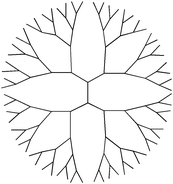Dendrimers are versatile, derivatisable, well-defined, compartmentalised chemical polymers with sizes and physicochemical properties resembling those of biomolecules e.g. proteins. The present critical review (citing 158 references) briefly describes dendrimer design, nomenclature and divergent/convergent dendrimer synthesis. The characteristic physicochemical features of dendrimers are highlighted, showing the effect of solvent pH and polarity on their spatial structure. The use of dendrimers in biological systems are reviewed, with emphasis on the biocompatibility of dendrimers, such as in vitro and in vivo cytotoxicity, as well as biopermeability, biostability and immunogenicity. The review deals with numerous applications of dendrimers as tools for efficient multivalent presentation of biological ligands in biospecific recognition, inhibition and targeting.
Dendrimers may be used as drugs for antibacterial and antiviral treatment and have found use as antitumor agents. The review highlights the use of dendrimers as drug or gene delivery devices in e.g. anticancer therapy, and the design of different host–guest binding motifs directed towards medical applications is described.
Other specific examples are the use of dendrimers as ‘glycocarriers’ for the controlled multimeric presentation of biologically relevant carbohydrate moieties which are useful for targeting modified tissue in malignant diseases for diagnostic and therapeutic purposes. Finally, the use of specific types of dendrimers as scaffolds for presenting vaccine antigens, especially peptides, for use in vaccines is presented.


 Please wait while we load your content...
Please wait while we load your content...